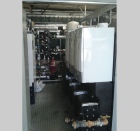Remeha solves asbestos contamination problem

Three Remeha Quinta Pro boilers on a cascade system were specified as part of a solution to retrofitting energy-saving heating safely and quickly at a Surrey school with ventilation, location and asbestos problems in its existing basement plant room. The previous boilers at Woodlea Primary School were 20 years old, and Kier Facilities Services was keen to specify a system that could be installed quickly to ensure good management of the asbestos situation and no disruption during the school day.
Phil Clayton of Kier Facilities Services in Basingstoke and Frederick So of Surrey County Council’s property M&E team and Remeha Commercial designed a boiler enclosure that would effectively create a remote boiler house for central-heating and hot-water services. The enclosure and boiler installation were completed in a day and enable all future maintenance and operation to take place securely from the outside.
About 75% of England’s 24 000 schools are estimated to have some buildings with asbestos, according to a report by the committee on carcinology for the Department of Education.








